1995
CHINA - KOREA FIBRE OPTIC CABLE
The Chinese and Korean authorities awarded the contract for
supplying and laying the cable to the Tasman Cable Company, Sydney, Australia. They in
turn contracted Sino British Submarine Systems, who used Flexservice 3, to lay the 585 km
long cable, which was buried throughout its length to avoid damage by trawlers.
The stamp was originally due to be issued on 15 December
1995, but at the last moment it was cancelled without any reason being given. FDC had
already been prepared and cancelled with the special postmark for the 15 December 1995.
Rather than waste all these covers the Chinese National Philatelic Corporation added an
additional copy of the cable stamp plus a 30 fen stamp to cover registration. These were
cancelled with a normal postmark on the new day of issue 8 February 1996.
The Korean shore ends were landed at Taean, the Chinese at
Qingdao, Shandong Province. The second FDC is cancelled with the regular postmark of
Qingdao and a special postmark dated 8 February 1996.
The rectangular cachet at the bottom of the cover states.
"The date of issue of the commemorative stamp for the opening of the China - Korea
submarine cable has been changed to 8 February 1996."
The FDC information was supplied by Fuchen Wang, Nanjing, PR
of China. |

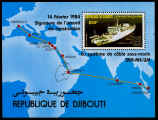
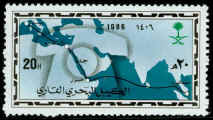

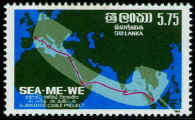


|
SEA
ME WE 1 Djibouti
1984 250f
Djibouti 1986 100f
Indonesia 1986 140-350r
Saudi Arabia 1986 20-50h
Singapore 1986 10-75c
Sri Lanka 1986 5r75
Djibouti 1984 250f commemorates the signing of the agreement
to instal SEA ME WE 1
SEA ME WE:- South East Asia - Middle East - Western Europe, a
13500 km (7275 nm) co-axial cable linking Singapore and France with landings at Indonesia,
Sri Lanka, Djibouti, Saudi Arabia, Egypt and Italy.
Segment A:- Singapore - Indonesia 641 km with 70 repeaters
laid by CS Vercors and manufactured by Submarcom. Opened for service 15 November 1984.
Capacity 1260 circuits.
Segment B:- Indonesia - Sri Lanka 2638 km with 223 repeaters,
laid by CS Cable Venture and manufactured by NEC. Opened for service 31 December 1985.
Capacity 1080 circuits.
Segment C:- Sri Lanka - Djibouti 4326 km long with 287
repeaters, laid by CS Vercors and manufactured by Submarcom. Opened for service 31
December 1985. Capacity 1080 circuits.
Segment D:- Djibouti - Saudi Arabia 1443 km with 108
repeaters laid by CS Cable Venture and manufactured by Standard Telephone & Cables
Ltd. Opened for service 31 December 1985. Capacity 1200 circuits.
Segment E:- Saudi Arabia - Egypt 1293 km with 156 repeaters
laid by CS Vercors and manufactured by Submarcom. Opened for service 31 December 1985.
Capacity 2580 circuits.
Segment F:- Suez - Alexandria 390 km land line with 86
repeaters manufactured by Siemens. Opened for service 10 June 1986. Capacity 2100
circuits.
Segment G:- Egypt - Italy 1908 km with 194 repeaters laid by
CS Vercors and manufactured by Submarcom. Opened for service 28 February 1986. capacity
2580 circuits.
Segment H:- Italy - France 946 km with 99 repeaters laid by
CS Vercors and manufactured by
Submarcom. Opened for service 20 April 1986. Capacity 2580 circuits.
The complete cable was officially opened on 8 September 1986 and was withdrawn from service in 1999.
Click here for the
main page on this cable. |
| SEA ME WE 2 Djibouti
1991 130f
A 18000 km fibre optic cable, the first in this region, linking Singapore
and France with landings at Indonesia, Sri Lanka, India, Djibouti, Saudi Arabia, Egypt,
Cyprus, Turkey, Tunisia, Algeria and Italy.
SEGMENT 1 Singapore - Indonesia 1040 km long
with 8 repeaters laid by CS Vercors. The cable was manufactured by Alcatel Submarcom.
SEGMENT 2 Djibouti - Indonesia with branching
units to provide links to India and Sri Lanka. Djibouti to India 3665 km long with 28
repeaters was laid by CS Cable Venture and manufactured by STC Submarine Systems.
Indonesia - India branching unit 5465 km long
with 41 repeaters laid by CS Vercors. The cable was manufactured by STC Submarine Systems
1260 km and Alcatel Submarcom 4205 km.
SEGMENT 3 Suez - Djibouti with a branching unit
to Saudi Arabia 2760 km long with 20 repeaters laid by CS Global Sentinel and manufactured
by Submarine Systems Inc (AT&T)
SEGMENT 4 Alexandria - Suez two land cables both
passing through Cairo. Route 1: 400 km and Route 2: 470 km both manufactured by Alcatel
Cable.
SEGMENT 5 France - Egypt with branching units to
Algeria, Tunisia and Italy. Total length of all cable laid 3660 km with 31 repeaters all
laid by CS Vercors and manufactured by Alcatel Submarcom.
SEGMENT 6 Cyprus - Egypt 600 km long with 4
repeaters laid by CS Global Sentinel. The cable was manufactured by Submarine Systems Inc.
(AT&T)
SEGMENT 7 Turkey - Egypt 690 km long with 5
repeaters laid by CS Global Sentinel. The cable was manufactured by Submarine Systems Inc.
(AT&T) |
| SEA ME WE 3 Macau
1999 50a
SEA ME WE 3
1999 8p
Souvenir sheet
A 40000 km fibre optic cable, opened for service
30 August 1999, linking the following countries (In alphabetical order).
Australia, Belgium, Brunei, PR China, Cyprus,
Djibouti, Egypt, France, Greece, Hong Kong, India, Indonesia, Italy, Japan, South Korea,
Macau, Malaysia, Morocco, Myanmar, Oman, Pakistan, Philippines, Portugal, Saudi Arabia,
Singapore, Sri Lanka, Thailand, Turkey, United Arab Emirates, United Kingdom, Vietnam.
Cable ships used to lay the cable were Agile,
Cable Installer, Maersk Defender, Maersk Fighter, Fresnel, Fu Lai, Nexus, Leon Thevenin
and Vercors
Manufacturers of the cable were Alcatel
Submarine Networks, AT&T - SSI, KDD-SCS and Pirelli
Click here for
the SEA-ME-WE 3 home page by France Telecom |
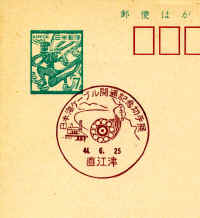

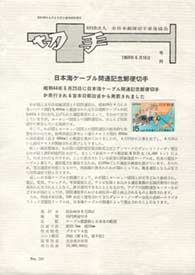
|
JAPAN SEA CABLE 1969
Japan 1969 Special cancellation
The 477 nm co-axial cable which ran from
Naoetsu, Sekiyama, Japan to Nakhodka, Maritime Territory, USSR, was installed by the
United States Underseas Cable Corporation for the Great Northern Telegraph Company and the
Kokusai Denshin Denwa Company. KDD Maru was chartered for laying the cable which was
manufactured by the Ocean Cable Company as were the 28 repeaters.
The special cancel dated 25 June 1969 is from
the Naoetsu Post Office and was issued on the day the cable opened for service.
The cable was taken out of service in July 1995.
It is now used by the Tokyo University for earthquake research.
This additional information was supplied by S.
Miura, Tokyo, Japan. |

